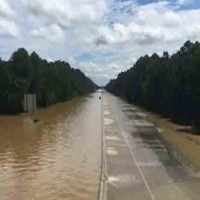
Did DOTD Worsen Flooding By Building Wall along I-12?
The Louisiana Department of Transportation & Development and 20 DOTD contractors who constructed the wall that runs down the middle of I-12 have been sued by four local governments in Livingston Parish and a host of individual citizens in Livingston and Tangipahoa parishes.
The wall, which varies from five to seven feet in height, was installed in 2015 as a means of preventing head-on collisions. But the plaintiffs allege this new wall resulted in thousands of homes receiving three to five feet of water in the flood of August 2016,
The plaintiffs are the cities of Walker and Denham Springs, Livingston Parish, and the Livingston Parish school board.
Damages could be in the hundreds of millions of dollars.
This litigation comes against the backdrop of previous litigation that found the State of Louisiana guilty of negligence in building I-12.
In the floods of 1983, more than 1,400 homes north of I-12 suffered enormous damage because I-12 was built like a dam, trapping water on the north side of Interstate. Victims of the 1983 flood sued and, after 19 long years, were awarded a judgment of $93 million against the State of Louisiana in 2002.
Because of “sovereign immunity” — the medieval doctrine that “the king can do no wrong,” the State of Louisiana cannot be forced to pay the judgment. Since 2002, the legislature has voluntarily appropriated $6 million toward the $93 million judgment, which with interest could be over $300 million.
If the plaintiffs in the current case involving I-12 are successful, the end result could be quite different. While DOTD is a defendant ultimately protected by sovereign immunity, the 20 private contractors that had a role in building the wall are not.
On one stretch of I-12 from the City of Denham Springs to the Town of Livingston, the five-to-seven foot wall in the center of the Interstate continues for a full 10 miles without a break. Photos of the stretch during the flood of August 2016 show an amazing amount of water right to the top of the wall on the north and an unflooded side to the south.
The wall is incredibly strong. During the flood, an engineer for one of the defendants posted on Facebook that the wall was standing up against “a billion gallons of water.” The post was soon taken down, but it appears to have been quite accurate.
At least three suits have been filed. The first two were initiated by Rick Ramsey, then Mayor of the City of Walker, when flood waters had barely receded.
The first suit is on behalf of citizens whose property was flooded as a result of the wall on I-12.
The second suit is on behalf of the four governmental bodies in Livingston Parish. It seeks to require the state to return the Interstate to its pre-2016 condition — before the wall was built — and prevent the wall from being extended further east as DOTD has planned.
The third suit was filed in Tangipahoa Parish by Byard “Peck” Edwards, an attorney and engineer, on behalf of Tangipahoa Parish residents who believe they flooded because of the way I-12 is constructed.
Livingston Parish president Layton Ricks said the parish joined the suit in order to support Walker and Denham Springs. He says there is no doubt widespread flooding and damage were caused by the wall, which contributed 3.5 to five feet to the flooding.
Ricks hopes the lawsuit will succeed at a minimum in getting the state to modify the wall, perhaps removing every third or fourth panel. In addition, he believes DOTD should terminate its plan to extend the wall all the way to the Mississippi border.
Mayor Ramsey said the wall on I-12 impacted flood waters as far west as Baker. When asked about that, Central Mayor Jr. Shelton said his gut reaction is that could well be true. He said he would like to see a study that would document it.


 June 26, 2017
June 26, 2017 







Comments are closed.